New 42-day free trial Get it now

Address verification services - A comprehensive guide
Address verification services are businesses who will check an addresses validity against authoritative address databases to ensure efficient delivery of bills, products, resources, marketing materials and more. Address verification services also greatly reduce reshipping costs, customer dissatisfaction, delayed service calls, and operational inefficiencies. Many address verification services offer real-time verification, autocomplete technology, geocoding services, and, often, property data attributes to provide the clearest picture of an address.
Table of contents
Address verification services & validation tools
The words “address validation” and “address verification” are often used interchangeably.
Both are synonymous with identifying if an address is real and valid.
Here are a few ways that you can start using address verification services and validation tools today.
Single address verificationEnter one US or international address at a time and check if it’s valid via the web interface. It’s free to use.
Batch upload address verificationUpload a list of US or international addresses to validate in bulk via CSV (up to 500,000 rows) with use of your Smarty subscription.
Command Line Interface address verificationUse your Smarty subscription to quickly process millions of US or international addresses.
US address validation APIIntegrate lightning-fast, real-time, address validation for US addresses directly into your application with an application programming interface to meet your specifications.
International address validation APIIntegrate real-time address validation for international addresses directly into your application with an application programming interface to meet your specifications.
Google Sheets address validation add-onBulk verify the list of addresses in your Google Sheets spreadsheet by downloading our Google Sheets add-on and using Smarty account subscription.
Microsoft Excel address validation add-inBulk validate the list of addresses in your Microsoft Excel spreadsheets by downloading our Excel add-in and using your Smarty subscription.
Postman address validation collectionThis Smarty Postman Workspace is the perfect place to experiment with new APIs using templated requests.
QGIS pluginBulk upload and validate a list of addresses and see them visually displayed on a map.
Introduction to address verification
What is address verification?
Address verification (also called address validation) is checking that a physical address is real against an authoritative address database. You want to know if you, or anyone else, could potentially find the location or send something there.
People will validate addresses as a way to ensure that the address they have is valid. A “match” means that the authoritative database you’re checking against also believes this physical address is valid. A non-match doesn’t mean your entered address isn’t real; it might be, but it indicates that the authoritative dataset doesn’t contain that specific address and, therefore, might not be valid.
Side note: If you've encountered the term "Address Verification System" (AVS), it's important to note that it typically refers to a fraud prevention tool used during credit card transactions to verify that the billing address provided matches the one on file with the card issuer.
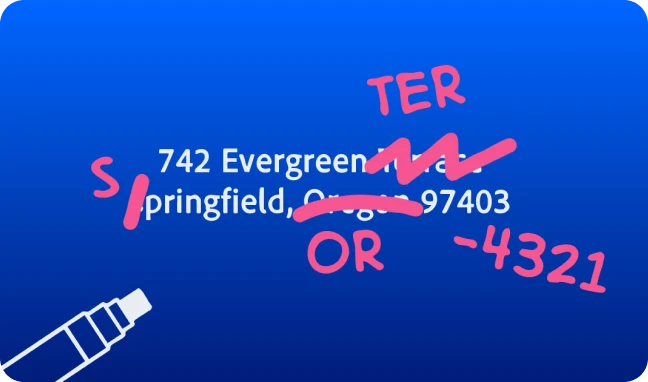
Why is address validation important?
Address validation has real-world impacts for many businesses and organizations. Institutions rely on address verification services to improve shipping accuracy, customer communication, and compliance with regulations. Improving those areas also decreases shipping costs, material waste, customer service hours, and legal fees while increasing fraud prevention, brand reputation, and overall revenue.
Here are a few case studies with example scenarios from real customers highlighting the importance of accurate addresses.
4Site Studios integrates address verification into their middleware to clean data behind the scenes without disrupting customer practices.
Faraday uses address verification to enhance AI customer predictions with better data going in.
Majority and Lake County GIS saw a significant decrease in undeliverable mail from using address verification.
Curatus, Kukun, 4Site Studios, AIRA, and the Epilepsy Foundation use address verification to deduplicate, standardize, and normalize their records.
A local last-mile delivery company and DialCare improve their delivery accuracy using address validation.
Express Mapping uses address verification to ensure compliance with public notice requirements.
Shippo and A3 Freight Payment significantly improve delivery logistics using address verification tools.
Sales Rabbit uses address validation to improve their pre-existing mapping & routing processes.
Rentler greatly reduced address fraud using address verification.
Address data fundamentals
What is address data? Address data components are the parts of an address that make up its whole. For example, a complete address will include parts (sometimes called metadata when parsed out) such as the street name, building number, ZIP Code, etc.
Smarty delivers address data components through our US Master Address List and address APIs. We provide up to 55 metadata points, including parsed address components, for over 210 million verified USPS and non-USPS addresses.
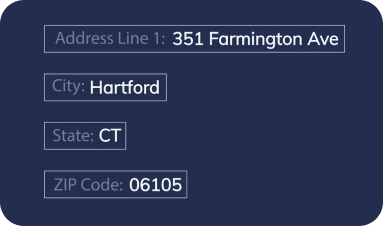
US address components - The anatomy of an address
Addresses are made up of many parts, and it’s important to understand what each one is. There’s no such thing as a stupid question about addresses. These suckers are more complex than most people imagine, so let’s dive into the pieces of an address and what they all mean.
Addressee—The person to whom the mail is addressed or to whom you would like to receive the mail at the included address. Also called the recipient, this can be a person or company.
Primary number—The specific house or building number, typically found at the beginning of most US addresses.
Street name—The official name of the street given by local authorities.
Street predirectional—The navigational direction (north, south, east, west, northwest, southwest, northeast, or southeast) that’s listed before the street name.
Street postdirectional—Directional information that’s included after the street name, such as north, south, east, west, northeast, northwest, southeast, or southwest.
Street suffix—Indicates the type of street we are dealing with. For example, is it Smarty Street? Smarty Road? Smarty Avenue? Smarty Circle? The suffix identifies the type of street and can be notated in full or abbreviated (e.g., Rd. for road, St. for street, etc.), giving rise to duplicate address matching issues.
Secondary number—A number that identifies a specific secondary designator (unit, suite, single lot, parcel, complex, apartment, floor, room, department, etc.) is listed after the secondary designator. For example, is it Unit 2, Unit 3, Unit 999, etc.?
Secondary designator—The type of space that the secondary number is attached to. It is the word that precedes the secondary number. For example, is it Unit 2, Suite 2, or Floor 2, etc.?
City—A name of the area smaller than the state but larger than the street where the mailing address is located. It’s an area where people live with an established government.
State—There are 50 constitutional political entities in the United States of America. This is the area that’s larger than a city yet smaller than the country.
ZIP Code—The term "ZIP" in ZIP Code stands for "Zone Improvement Plan,” and a ZIP Code is a 5-digit number that specifies an individual destination post office or mail delivery area in the USA. These numbered codes help to determine mail sorting for more efficient postal processes and parcel/mail delivery.
ZIP+4 Code—This is just like it sounds: a regular ZIP Code with an additional 4 digits added at the end for increased specificity. Because of this, it is also referred to as a 9-digit ZIP Code or ZIP 9. As the US population grew and expanded, ZIP+4 Codes were incorporated to continue to provide efficient mailing services with more specified postal routes.
Primary number—The specific house or building number, typically found at the beginning of most US addresses.
Street name—The official name of the street given by local authorities.
Street predirectional—The navigational direction (north, south, east, west, northwest, southwest, northeast, or southeast) that’s listed before the street name.
Street postdirectional—Directional information that’s included after the street name, such as north, south, east, west, northeast, northwest, southeast, or southwest.
Street suffix—Indicates the type of street we are dealing with. For example, is it Smarty Street? Smarty Road? Smarty Avenue? Smarty Circle? The suffix identifies the type of street and can be notated in full or abbreviated (e.g., Rd. for road, St. for street, etc.), giving rise to duplicate address matching issues.
Secondary number—A number that identifies a specific secondary designator (unit, suite, single lot, parcel, complex, apartment, floor, room, department, etc.) is listed after the secondary designator. For example, is it Unit 2, Unit 3, Unit 999, etc.?
Secondary designator—The type of space that the secondary number is attached to. It is the word that precedes the secondary number. For example, is it Unit 2, Suite 2, or Floor 2, etc.?
City—A name of the area smaller than the state but larger than the street where the mailing address is located. It’s an area where people live with an established government.
State—There are 50 constitutional political entities in the United States of America. This is the area that’s larger than a city yet smaller than the country.
ZIP Code—The term "ZIP" in ZIP Code stands for "Zone Improvement Plan,” and a ZIP Code is a 5-digit number that specifies an individual destination post office or mail delivery area in the USA. These numbered codes help to determine mail sorting for more efficient postal processes and parcel/mail delivery.
ZIP+4 Code—This is just like it sounds: a regular ZIP Code with an additional 4 digits added at the end for increased specificity. Because of this, it is also referred to as a 9-digit ZIP Code or ZIP 9. As the US population grew and expanded, ZIP+4 Codes were incorporated to continue to provide efficient mailing services with more specified postal routes.
If there’s an address term that you’ve heard but don’t see listed above and would like to know more about, feel free to skim through our glossary for common terms and address-related know-how.
Typical US address component formatting
US addresses follow a set of formatting conditions to help mail get where it needs to go the first time you send it. Below, you will find an ordered list of the typical component formatting to help you achieve just that. Let’s go!
Addressee line - The first/top line in typical US address formatting will include the person or company's name at this address.
Care of (optional) - This is optional information. Still, if your mail needs to be directed to a specific person or business department, you could include that information on the second line down. For example, “Care of Xavier Institute for Higher Learning” would be listed below your addressee line, “Professor Charles Xavier.”
Business line (optional) - This is similar to “Care of” but in a different style geared towards businesses rather than organizations or non-profits. Should you choose to include this information, it would go in place of “Care of” immediately below the “Addressee line.”
Address line 1 - This is the first line in the street address. (Yes, the recipient and care of people don’t actually count as part of an address, although we do like having them get things to the right person.) This line contains the building or house number, predirectionals (if there are any), street name/PO Box, postdirectionals (if there are any), and street suffixes. If there are any secondary address designators (suite numbers, unit numbers, etc.), those can also be included at the end of this line.
Address line 2 - This is an optional line to include secondary address information such as apartment, unit, or suite numbers, etc. We highly recommend structuring your forms with your secondary address information being included at the end of Address Line 1 as this is the best way to avoid confusion.
Last line - This should be the final line of an address that includes the city, state, and ZIP Code.
Country - If mailing internationally (from inside the US to outside the US), the destination country should be included below the last line.
Care of (optional) - This is optional information. Still, if your mail needs to be directed to a specific person or business department, you could include that information on the second line down. For example, “Care of Xavier Institute for Higher Learning” would be listed below your addressee line, “Professor Charles Xavier.”
Business line (optional) - This is similar to “Care of” but in a different style geared towards businesses rather than organizations or non-profits. Should you choose to include this information, it would go in place of “Care of” immediately below the “Addressee line.”
Address line 1 - This is the first line in the street address. (Yes, the recipient and care of people don’t actually count as part of an address, although we do like having them get things to the right person.) This line contains the building or house number, predirectionals (if there are any), street name/PO Box, postdirectionals (if there are any), and street suffixes. If there are any secondary address designators (suite numbers, unit numbers, etc.), those can also be included at the end of this line.
Address line 2 - This is an optional line to include secondary address information such as apartment, unit, or suite numbers, etc. We highly recommend structuring your forms with your secondary address information being included at the end of Address Line 1 as this is the best way to avoid confusion.
Last line - This should be the final line of an address that includes the city, state, and ZIP Code.
Country - If mailing internationally (from inside the US to outside the US), the destination country should be included below the last line.
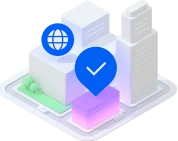
Global address components
When we expand into global address components, the list and order of components vary greatly. Some countries require exactly the same address components that the United States requires, but they need them in a different order, with or without punctuation. Other countries use additional address components that are foreign to the US. The country’s local post authority sets the rules on how it will accept and route mail.
Here is a list of additional address components that you may see are required when mailing internationally.
Postal codes—A string of numbers and sometimes letters that help postal services understand where a piece of mail is being sent. It’s used to aid the local postal workers in their routing, similar to the US ZIP Codes and ZIP+4 Codes. (Smarty has a ZIP Code API that’s pretty neat, easy to use, speedy, and loaded with comprehensive ZIP Code data.)
Locality—nations outside the US will use this word to refer to what the US calls a city’s name.
Administrative area—This is another word for what the United States calls a state or province name or abbreviation.
Administrative area ISO—This is only available in some countries. The value is the two-letter country code followed by a hyphen, finished with a 1-3 character code unique to the administrative area. (ex. CA-ON)
Dependent locality—Any additional information surrounding a city can sometimes be necessary. For example, a town or neighborhood in Turkey might be considered a dependent locality.
Double-dependent locality—This is even more granular than a dependent locality. It refers to a business park, industrial sector, or hamlet. It is frequently used in countries with more dense populations.
Premise—This is synonymous with primary number in the US, and it represents the building or house number associated with an address.
Thoroughfare—This is synonymous with street name in the US, and it represents the name of the street where the address is located.
Locality—nations outside the US will use this word to refer to what the US calls a city’s name.
Administrative area—This is another word for what the United States calls a state or province name or abbreviation.
Administrative area ISO—This is only available in some countries. The value is the two-letter country code followed by a hyphen, finished with a 1-3 character code unique to the administrative area. (ex. CA-ON)
Dependent locality—Any additional information surrounding a city can sometimes be necessary. For example, a town or neighborhood in Turkey might be considered a dependent locality.
Double-dependent locality—This is even more granular than a dependent locality. It refers to a business park, industrial sector, or hamlet. It is frequently used in countries with more dense populations.
Premise—This is synonymous with primary number in the US, and it represents the building or house number associated with an address.
Thoroughfare—This is synonymous with street name in the US, and it represents the name of the street where the address is located.
Global address component formatting
There are 250+ countries and territories, and many handle addresses uniquely. We have created global address formatting pages to help ensure your mail gets where it needs to go internationally. If you’d like to read more about different postal practices around the world, here are a few fun reads.
Canada gave a unique postal code for letters to Santa Claus.
Germany uses mini post offices called Packstations in addition to regular postal offices.
France has some jaw-dropping prohibited mailing protocols. (They really had to make a rule for that?)
The United Kingdom likes to spice things up by putting the return address in a completely different spot than we do in the US.
Differences in address formatting worldwide
There are unique examples of specific formatting requirements for various countries. We’ve captured the boatload here on our global address formatting pages. If you’d just like to skim through a few, though, feel free to keep scrolling, soldier.
Japan 🇯🇵
Japan is an interesting example of how mail can be formatted differently for many different reasons. For example, when addressing mail in Japan, they write the address vertically rather than horizontally, as many Western countries do. This fits with how they read and write. The order of elements also works more like a magnifying glass effect, starting with the largest spaces and then getting down to the granular address components towards the end of the address, the exact flip of how the US orders their components.
Russia 🇷🇺
Russia has a unique addressing format because it tends to separate almost every piece of the address into its own line. It’s also fairly common in Russian addresses to see RUS (the country ISO) or the full country name, “Russia,” written out, even when mailing from one Russian address to the next. How’s that for pride in your country?
India 🇮🇳
India is unique in the sense that it has a double-dependent locality. Because of India’s higher population density in business and living communities, its postal system is organized to get down to the nitty-gritty. Including a double-dependent locality ensures that the parcel being sent makes it to its final destination quicker, as it’s easier to sort.
Antarctica 🇦🇶
Antarctica is completely unique in addresses. They have mostly a population of penguins and polar bears, so the entire continent is considered a “no fixed address” zone. Fun fact: The closest things Antarctica has to an address is the names tied to each of its research stations, like McMurdo, Palmer, and Concordia. But even then, there’s no official postal system—just a lot of determined researchers and sled dogs (okay, maybe no dogs anymore, but the imagery is fun, right?).
Common international address validation problems
People run into many common address validation problems. Here’s a quick rundown on what they are and how to fix them.
Typos and formatting inconsistencies
Typos happen just because we are human, but there are also several acceptable and widely used abbreviations for the same word. Is it supposed to be “St.” “Str.” “ST.” or “STR.” if we’re abbreviating the word “street?”
In the words of our almighty address experts… “it depends.”
This can lead to formatting inconsistencies as well. At first glance, this might not appear to be a big issue (who really cares how we input the word “street?”). However, with a deeper analysis, you can see that not having a consistent format can lead to duplicate addresses in your system, which wastes money and skews your ability to assess your market effectively.
To correct these common formatting, abbreviation, and typo mistakes, you may require some type of address correction service.
Understanding US postal standards
Regional and global standards vary. Sometimes, non-US mailing and shipping standards are similar to those of the United States of America, but oftentimes, knowing the inconsistencies can make a difference in your ability to mail something. (There’s a difference between mailable, shippable, and deliverable, and you can read more about that here.) Here are a few resources to help you understand postal standards and why they are the way they are:
USPS Publication 28
The USPS publication 28 is the place to go to get more information on USPS’s postal addressing standards. The goal of their standards is to provide “guidance on the most efficient means to output an address to a mailpiece.” They discuss regional formatting practices and commonly accepted business mailing standards for the USA.

CASS certification
CASS stands for the Coding Accuracy Support System (CASS) and is a certification tool created and used by the USPS to ensure database accuracy. A provider that is CASS certified has to meet specific requirements of the USPS, such as using LACSLink when validating/verifying addresses. CASS certification is superior to NCOA certification for address verification, and CASS Cycle O is the latest update to CASS certification rules that refine the address-matching process for better accuracy and efficiency.
ISO address format
Contrary to a common misconception, ISO addressing pages aren’t there to create or promote a uniform address globally. That would be silly, as there are different languages involved. Instead, ISO formatting facilitates interoperability between addresses and promotes good data governance and data management practices. They’re looking at improving data quality for all.
Address transliteration
Speaking of different languages, if you want to know more about how to address mail to other countries that primarily use non-Latin languages, you may want to check out our resources for address transliteration. Transliteration is used in address validation to convert the characters of an address in one alphabet or script to another. It’s not the same as translating. Transliteration is focused on preserving the phonetic representation of the words.

Project US@
Project US@ (pronounced Project USA) is an address standardization initiative to assist healthcare providers with interoperability between facilities such as hospitals, clinics, labs, etc. The consistent formatting ensures that a standard format for an address is used, thus eliminating the likelihood of breaching strict compliance laws, such as HIPAA and ACA, while assisting in the deduplication of records and decreasing incorrect patient matching instances. It’s a requirement to follow Project US@ formatting standards if you wish to become or join a Qualified Health Information Network (QHIN).

How it works - The steps of address verification
There are typically 5 steps to validate or verify addresses. We’ve provided them below in order for your convenience, but feel free to click through the links if you want to get to know the process on a more technical level.
- Pick your provider. Many companies can verify addresses for you, but we have a feeling you aren’t looking for just anyone.If you’re wondering if there’s an open-source or free address validation out there, the short answer is “yes”, but they won’t satisfy most use cases. Here’s a list of free or open-source address validation providers and a brief evaluation of their products and services:USPS address verification: In a nutshell, this tool is free to use but only contains addresses in the USPS database. It has no international support, a slower user experience, and strict terms of service. It’s also missing several points of metadata that may help you and your team determine deliverability.UPS Address Validation: This is a free tool to use, but the UPS Address Validator skips validating house numbers, ignores apartment numbers, and doesn’t allow database address cleaning. They also frequently experience slow API response times and are difficult to implement, even if you’re an engineer. Additionally, they’re not CASS-certified.FedEx address validation: They only have street-level address validation, so the least precise level of address validation is what you’ll get going with them.Google address validation: This is a newer product that’s geared mostly toward ecommerce usage. The parsing can be inconsistent, and there are some limitations you should look into before going with this provider.Smarty Single Address Validation Tool: This tool demonstrates address autocomplete, geocoding, and validation in one. The results are highly accurate. The limitation is that you can only validate a single address at a time for free. Free trials and reasonably priced paid subscriptions are available to process as many addresses as you need. Best address validation services compared, according to G2: Just pick Smarty. We look out for you. 🙂
- After you pick a provider, they’ll “lookup” each of your addresses against their authoritative database and start by parsing them into components. (This is fancy speak for separating out all the parts of the address into individual fields.)
- Following parsing, address standardization (also called normalization) will convert your data into an acceptable format for your local postal authority (USPS? La Poste? Wherever!)
- Now that your address or addresses are in the right format, they’ll be compared to authoritative databases to validate/verify. This can happen regionally or internationally.
- Ok, so there really are only 4 steps, but if you want your address data to be a little extra spicy, it can be important to enrich it with property data and/or demographic data and analyze the results. Understanding whether or not the address was valid, corrected, or marked as invalid can be an important final step to maintaining a stellar and clean address database.
Side note: while there are typically 5 steps in address verification, Smarty invented a clever way to consolidate them behind the scenes, which is one reason we’re so wicked fast.

Types of address verification services
There are many different levels of address verification accuracy. We’ll discuss these address verification types in terms we have all come to know and love: okay, better, best, bestest, and super bestest! 😘
Okay ⭐️
City and Zip-level validation—Want to validate a city, state, or ZIP Code? See the option to do so in Smarty’s free Single Address Validation Tool. You can also enter city and state to find the ZIP Code(s) or enter the ZIP Code to find city(s) and state(s). Additionally, you can use it to find a county by address, ZIP Code, or city.
Better ⭐️⭐️
Street-level validation—Your address is only verified to the street name, meaning that the street contains valid addresses, but the one you entered may or may not be a valid one.
Best ⭐️⭐️⭐️
Delivery point validation—This will verify that your address has delivery point validation (DPV), meaning that it has a known point of delivery where mail could potentially be sent, depending on your organization’s deliverability guidelines. This is especially useful for shipping or mailing to larger organizations like a hospital or college campus that might have a unique ZIP Code assigned to them.
Bestest ⭐️⭐️⭐️⭐️
Secondary address validation—This verifies that the address you entered is valid, even down to the secondary address indicators, such as apartment numbers, unit numbers, or anything else that you might write on Address Line 2.
Super Bestest ⭐️⭐️⭐️⭐️⭐️
Non-USPS / non-postal address validation—Many US addresses are included in the USPS database. However, several other 3rd-party vetted addresses that the USPS hasn’t picked up yet are still valid and verified. Smarty helps you verify over 20 million non-USPS/non-postal addresses to the secondary address level so that your customer reach goes further.
Ways to verify addresses
Three common ways to verify addresses include single, bulk, and API.
Single address verification: Ideal for verifying individual addresses, this method allows you to input a single address into our user-friendly tool. Smarty offers this to you for free.
Bulk address verification: Designed for organizations dealing with large volumes of addresses, this approach enables the processing of multiple addresses simultaneously. Users simply upload addresses; no coding is required. See 5 easy bulk address interfaces.
Address verification via APIs: For seamless integration into your existing systems, address verification APIs provide real-time validation during data entry. This ensures that addresses are correct before they enter your database, reducing errors and improving operational efficiency.
Address verification use cases by industry
Many industries use address verification services to increase operational efficiency, reduce waste, improve customer relationships, boost ROI, prevent fraud, define address boundaries, conduct market research, and more. Here are a few examples of how different industries are using Smarty’s address verification products and tools:
Telecommunications (Here’s a bonus page to help you look smarty-er while talking to your telecom boss about why you need address verification)
Government services (FIPS Code lookups, anyone?)
Types of addresses
There are many different types of addresses, and understanding and differentiating between them will help your organization determine which level of address verification is right for you. We’ve also included some interesting addresses for you to look at in case reading this page has made you fall in love with address data like we have.
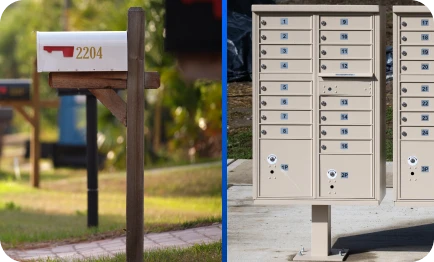
Physical vs. mailing addresses
A physical address and a mailing address are similar in many aspects, but what sets them apart is that a physical address is where you’re physically located on the earth. A mailing address is where you can receive mail. Sometimes, this can be the same thing, but it isn’t always. You can read more about the difference between physical and mailing addresses here.

Residential vs. commercial addresses
Residential addresses are where a person lives. Although some people could claim they live at their job (maybe take a vacation once in a while, will ya?), commercial addresses specifically refer to a place of business. Commercial and residential addresses are noted via the residential delivery indicator (RDI) included in some address verification tools (only the best ones). Why does knowing the difference matter? Because many private mail carriers will charge one rate for shipping to a commercial address and a different rate for residential addresses. Knowing the difference also helps with a myriad of market and marketing analyses.
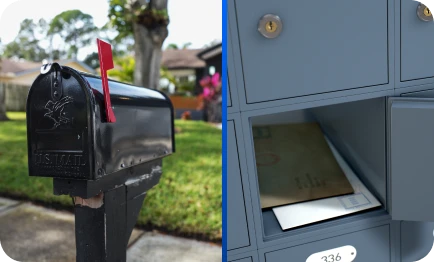
PO Box vs. street addresses
A street address and a PO Box address differ because while a street address is usually tied to a residence where someone is currently living, PO Boxes are located at the post office (hence the PO for Postal Office). The USPS prefers to deliver mail to a PO Box as it’s cheaper for them to do so (they don’t have to pay the carrier salary or vehicle fuel, maintenance, and insurance costs to do it. Your organization may want to understand the difference so you can set your company preference on which address to send to if you happen to have both!
Note of interest: While we’re on the topic of PO Boxes, did you know there are some US ZIP Code areas where the USPS only delivers to PO Boxes? These have been creatively and cleverly named PO Box-Only ZIP Codes. Think of rural areas like Jackson Hole, Wyoming, where 83002, a ZIP Code there, is designated exclusively for PO Box addresses.
Mappable vs. valid addresses
The difference between “mappable” and “valid” addresses is crucial for ensuring accurate deliveries and reliable address data. Mapping services like Google Maps can display the probable location of an address, but they don't confirm its existence or deliverability. In contrast, address validation services, such as those offered by Smarty, verify whether an address is recognized by official postal authorities and capable of receiving mail.
Funny addresses
Sometimes, people are just silly and make addresses funny. We compiled a list of these jokester-inspired addresses for you to peruse for funsies, kicks, and giggles. Even silly-looking addresses can be valid and should be verified before being discounted as made-up. You’d be surprised what’s out there.
Scary addresses
Maybe you aren’t in the mood to chuckle and would rather be scared by addresses instead. Here are some creepy addresses that are sure to leave you quivering behind your screen. Warning, these pages talk about the scariest type of address (an unverified or invalid one). 🫣
Address metadata
Address metadata is just a spiffy way of saying extra details on an address are available! This can help your organization to better understand your customers or users who live and work at those addresses a little bit better. You can access 55 points of metadata using Smarty’s address verification tools, but here are some of the most common data points you may be looking for:
FIPS Codes: FIPS stands for Federal Information Processing Standards. These are are basically 2 to 5 digit codes to represent states and counties. Understand county data and boundary lines a little better with this little nugget of data.
County info: ZIP Codes cross county and even state lines frequently, but we know the details and are happy to share them with you in your results.
Address persistent unique identifier: SmartyKey® is our persistent, unique identifier (a unique, never-changing 10-digit number assigned to each address) that will track changes to an address over time, letting you know which verified address is the most up-to-date one and which are the older aliases.
eLot codes: indicate the sequence in which a mail carrier delivers to addresses within a specific ZIP+4 area. Because it makes sorting mail easier for the post office, using eLot (enhanced line of travel) from the USPS can save you postage money, and we like saving you money. Pair this piece of data with Delivery Sequence File 2 (DSF2) to have an all-encompassing solution for bulk mail.
LacsLink: (Locatable Address Conversion System Link) converts rural-style addresses to city-style addresses, often due to 911 emergency system implementations designed to reduce response times.
Unique ZIP Codes: Larger institutions (like a military base, college campuses, or hospitals) have specialized and unique ZIP Codes to make life easier for the men and women in the blue and khaki shorts to do their jobs. Rather than trying to find every building on a military base or college campus, a unique ZIP Code gives these troops a unique drop spot for the organization to sort out on their own time.
Delivery point validation (DPV): Need to be able to send mail with confidence that it will get there? Delivery point validation is a process that confirms whether a specific address is deliverable.
DPV no stat: The USPS is temporarily declaring the address undeliverable, such as a building under construction or one recently demolished.
Residential delivery indicator (RDI): Not sure if the address you keep marketing to is an individual or a business? Well now you can know with this awesome metadata field.
County info: ZIP Codes cross county and even state lines frequently, but we know the details and are happy to share them with you in your results.
Address persistent unique identifier: SmartyKey® is our persistent, unique identifier (a unique, never-changing 10-digit number assigned to each address) that will track changes to an address over time, letting you know which verified address is the most up-to-date one and which are the older aliases.
eLot codes: indicate the sequence in which a mail carrier delivers to addresses within a specific ZIP+4 area. Because it makes sorting mail easier for the post office, using eLot (enhanced line of travel) from the USPS can save you postage money, and we like saving you money. Pair this piece of data with Delivery Sequence File 2 (DSF2) to have an all-encompassing solution for bulk mail.
LacsLink: (Locatable Address Conversion System Link) converts rural-style addresses to city-style addresses, often due to 911 emergency system implementations designed to reduce response times.
Unique ZIP Codes: Larger institutions (like a military base, college campuses, or hospitals) have specialized and unique ZIP Codes to make life easier for the men and women in the blue and khaki shorts to do their jobs. Rather than trying to find every building on a military base or college campus, a unique ZIP Code gives these troops a unique drop spot for the organization to sort out on their own time.
Delivery point validation (DPV): Need to be able to send mail with confidence that it will get there? Delivery point validation is a process that confirms whether a specific address is deliverable.
DPV no stat: The USPS is temporarily declaring the address undeliverable, such as a building under construction or one recently demolished.
Residential delivery indicator (RDI): Not sure if the address you keep marketing to is an individual or a business? Well now you can know with this awesome metadata field.
When it comes to mailing parcels or letters, the metadata discussed in the previous section can greatly affect your ability to ship with confidence, efficiency, and cost-effectiveness. Returned mail can eat into revenue if you let it, so let’s stop that. Address verification services can help you correct your database now and in the future as your empire grows.

Address APIs
Address APIs are tools you can use to change or manipulate addresses to be more valid, complete, or standardized. Smarty’s APIs are cloud-based, giving you a cost-effective, hyper-speedy, and quickly updatable process that seamlessly integrates with your existing programs. (We mean it, too. Smarty can validate over 75,000 addresses per second against our own database.)
Smarty’s APIs are available to test out live and for $0 (and 0 cents). There are 4 API tools that are specific to address validation, but you can see all of the tools by going here and clicking the dropdown arrow or scrolling along the sidebar menu.
Address validation APIs
US street address validation API—Validate US street addresses with the click of a button. Your devs will thank you for using us once they see our documentation. We know how to make nerds sweat.
International street address validation API—You know what to do; click that link to test the international API now.
US ZIP Code API—Look up and verify city, state, and ZIP Code combos.
US Extract API—Find and validate addresses in arbitrary text input (a big chunk of text) with extraction endpoints. Basically, that’s nerd speak for, “We can take a ton of text that may or may not contain addresses and find and then validate any possible addresses found within.” Yay.
Non-Smarty address validation API providers
Smarty isn’t the only provider out there with address validation APIs, but we will warn you that they have some caveats to using them. Here’s some research we’ve done on each of the more common providers and what they may or may not be telling you:
Ways to validate an address using other code languages
A lot of programmers out there might just want to know how to validate addresses in the ways they know best: the code. Smarty provides address validation SDKs in 10 languages, including:
Ease of API implementation
Address verification providers can make API implementation straightforward or a nightmare. Here’s what you should look for:
Comprehensive documentation: Detailed guides and tutorials are available for each API, facilitating seamless integration.
Live address API playground: Developers can test and experiment with APIs in real time, ensuring functionality aligns with project requirements.
SDKs and code samples: A variety of software development kits and examples are provided, supporting multiple programming languages.
Local API installation options: For environments requiring on-premises solutions, local installations are supported.
Responsive support team: Expert assistance is readily available by phone to address any integration challenges.
Implementation tips
Here are a few tips and tricks to make implementing your address verification solution even smoother and keep your address database squeaky clean:
- Watch out for address false positives, and don’t let them sneak in undetected. These addresses like to walk and talk like an address, but they aren’t valid. See the aforementioned link for steps to ensure the bad data stays out.
- Become the master of address exception handling by proactively managing your no-matches with exceptions to the rules. You can automate this, perform the task manually, or (this is our favorite option) have a little bit of both in a hybrid approach.
- Understand your address validation provider’s latency track record and uptime before signing the dotted line. You should be able to tell what they promise you by looking at their SLA (service level agreement) and hold them to that standard.
- Choose a provider who will protect your clients’ personally identifiable information with their lives, or at least their livelihoods. The last thing you want or need is to be slapped with a fine immediately after implementation for not following some government entity’s rules.
- We know you wanna use Regex for address validation, but stop. It’s a trap (say that in your best Admiral Ackbar voice). Addresses aren’t regular, so using any form of expression will require a lot of code for it to only maybe, kinda work.
- In live address-entry applications, we suggest presenting the validated address back to the person entering it for their review/confirmation. It’s just good practice to assist with your data accuracy.
What to do following address verification/API implementation
If you’ve validated addresses and managed your data like a boss, you probably think you’re done, right? Well…
Related learning
Use cases
See how organizations around the world are benefiting from our services

Address Autocomplete improves customer checkout process
How Address Autocomplete Helped Fabletics Improve Checkout Page Optimization

Rooftop Geocodes for Weather Risk Modeling
Predicting future risk for pre-construction homes requires precise location data.

Data cleansing for accurate addresses in PropTech
Data cleansing enhances address data aggregation in PropTech.